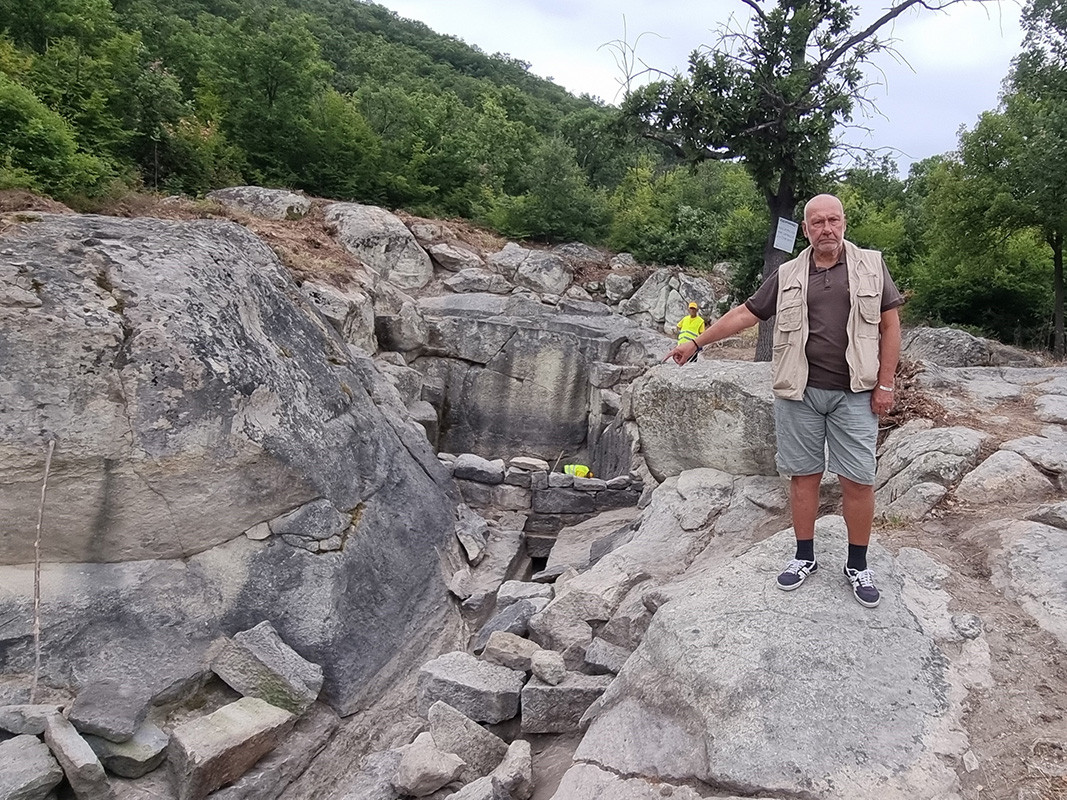 7
7
Bulgaria is studded with archaeological sites, and Perperikon, the big archaeological complex in the Eastern Rhodopes, has never ceased surprising researchers. The latest news from Perperikon is connected with the details now being revealed from the ancient water temple or nymphaeum discovered there. This historic discovery has opened up new avenues for comprehending the ancient history of this region, says historian and archaeologist Prof. Nikolay Ovcharov in an interview with Maria-Mira Hristova from the BNR’s culture channel Hristo Botev.
The studies conducted by the archaeologist and his team supported the theory that in Perperikon’s Southern quarter there was a water temple or nymphaeum, dating to the 2nd-3rd century. It was a temple dedicated to nymphs – the mythological divinities of water believed to inhabit water springs and basins.
“The water temple was one of the first things travelers laid their eyes on when they arrived at Perperikon during the Roman period (2nd-5th century),” Prof. Ovcharov says.
“At the time, the Southern quarter, which we have been studying for seven years, was entered through an anticline where there was a fork in the road linking Perperikon with Via Egnatia - the famed Constantinople-Rome road running along the shore of the Aegean. After making a thorough study of the Acropolis, i.e. the fortified part of Perperikon, we spent the past few years exploring the fascinating Southern neighbourhood, which surprised us in many ways.”
The study of the region showed that the residential areas of the rock city were not full of living quarters for the poor, quite the opposite:
“It turned out that the Southern quarter, especially during the Roman period, was literally covered in places of worship,” Prof. Ovcharov says. “The water temple was in fact a huge reservoir where water for the household needs of the neigubourhood was collected. On the other hand, the façade consisted of columns, statues and cornices. There was a water fountain inside for travelers to drink from. Upon entering, they faced temples to different gods, and the mausoleums of Perperikon’s wealthiest citizens, i.e. the Southern quarter actually turned out to be a huge surprise because in Roman times, this vast terrace was used entirely for the construction of cult buildings.”
Water temples are relatively few and far between in out lands, the tradition of building them having originated in Ancient Greece, the archaeologist says.
“In the timers of Homer, the water deities – the nymphs – were worshipped in natural surroundings. However, later, buildings were built, and in the Roman period they became huge. A classic example is the seven-storey nymphaeum in Rome, which was destroyed by the Popes in the 16th century. In the Roman period they combined different functions – worship of the nymphs with people’s household needs and had drinking water reservoirs which were essential for a mountain town.”
The discoveries at Perperikon came about as a result of 25 years of planned work. Prof. Nikolay Ovcharov’s team have been unearthing the city, literally metre by metre. “We have finished with the Acropolis, and have made a lot of progress in the Southern quarter,” the archaeologist says, and goes on to explain that it is slow work because “in the past two years the government abdicated and stopped financing Perperikon and five other priority archaeological sites in the country”. Now Kurdzhali municipality is backing the archaeologists and in 2-4 years’ time the entire city is expected to have been unearthed with its Acropolis and Southern quarter – Perperikon’s principal elements.
“We are working really hard right now. Alongside the dig itself, we are working on two European projects – the visitors’ centre is almost ready (a marble and granite palace at the foot of Perperikon), and for some weeks we have been working on an 8 million Leva project involving the restoration of 13 buildings from the Acropolis, the medieval church at the foot of the city, the water reservoir of the nymphaeum and what will perhaps be the pearl in the crown of Perperikon – the grand early Christian basilica in the Southern quarter. It is almost 40 metres long, and is the biggest church discovered in the Rhodopes to date. It is now being restored and will have its original columns, its capitals and a height of up to 3 metres – an impressive monument indeed,” says Prof. Nikolay Ovcharov.
The key to Perperikon was gifted to Pope Francis, Prof. Ovcharov says further. Actually, it is a replica of the silver key found in the ancient city, used to lock the episcopal casket. The key was the gift the Bulgarian delegation, headed by the Grand Mufti of Bulgaria, gave the Pope during an audience at the Vatican a few days ago.
Interview by Maria-Mira Hristova, Hristo Botev channel, BNR
Editing by Elena Karkalanova
Translated and posted by Milena Daynova
Photos: BTA
The history of the largest Bulgarian church in Bulgaria from the National Revival period "The Assumption of the Virgin Mary" in the town of Pazardzhik is long and interesting. It is assumed that the first church there was built in the 17th century. It..
On 10 August 1915, the first Bulgarian-built aeroplane took to the skies for a test flight in Bozhurishte. It was designed by inventor Assen Yordanov, whose name still features in the textbooks used to train pilots and engineers today. From an early..
A trilingual exhibition titled “Egyptian Cults around the Black Sea” opens today at 6 PM at the Archaeological Museum in Sozopol , according to BNR – Burgas. Part of an international research project, the exhibition is organized by the Institute of..
In 1018, after half a century of struggle, the First Bulgarian Empire was conquered by Byzantium. Despite the many uprisings of the..

+359 2 9336 661
